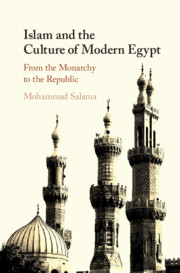Book contents
- Islam and the Culture of Modern Egypt
- Islam and the Culture of Modern Egypt
- Copyright page
- Dedication
- Contents
- Acknowledgments
- A Note on Transliteration and Translation
- Preface
- Introduction
- 1 History Matters
- 2 Nahḍa-t Miṣr: Zaynab and the Cultural Renaissance of Modern Egypt (1912–1913)
- 3 Blindness and Insight: Challenging the Sacred/Secular Divide in Ṭāhā Ḥusayn’s The Days
- 4 An Egyptian Sophocles: Qurʾānic Inspiration in Tawfīq al-Ḥakīm’s The People of the Cave
- 5 Writing the Mad Text: Freedom, Modernity, and God in Naguib Mahfouz’s “The Whisper of Madness”
- 6 Islamism Writes Back: ‘Alī Aḥmad Bākāthīr’s The Red Revolutionary and the Dismantling of the Secular
- 7 Secular Realism and Utopian Irony in Yūsuf Idrīs’s Faraḥāt’s Republic
- 8 Islam and Secular Nationalism in a Film Age: Unveiling Youssef Chahine’s Gamīla Al-Gazā’iriyya
- Book part
- Bibliography
- Index
- References
Bibliography
Published online by Cambridge University Press: 01 November 2018
- Islam and the Culture of Modern Egypt
- Islam and the Culture of Modern Egypt
- Copyright page
- Dedication
- Contents
- Acknowledgments
- A Note on Transliteration and Translation
- Preface
- Introduction
- 1 History Matters
- 2 Nahḍa-t Miṣr: Zaynab and the Cultural Renaissance of Modern Egypt (1912–1913)
- 3 Blindness and Insight: Challenging the Sacred/Secular Divide in Ṭāhā Ḥusayn’s The Days
- 4 An Egyptian Sophocles: Qurʾānic Inspiration in Tawfīq al-Ḥakīm’s The People of the Cave
- 5 Writing the Mad Text: Freedom, Modernity, and God in Naguib Mahfouz’s “The Whisper of Madness”
- 6 Islamism Writes Back: ‘Alī Aḥmad Bākāthīr’s The Red Revolutionary and the Dismantling of the Secular
- 7 Secular Realism and Utopian Irony in Yūsuf Idrīs’s Faraḥāt’s Republic
- 8 Islam and Secular Nationalism in a Film Age: Unveiling Youssef Chahine’s Gamīla Al-Gazā’iriyya
- Book part
- Bibliography
- Index
- References
- Type
- Chapter
- Information
- Islam and the Culture of Modern EgyptFrom the Monarchy to the Republic, pp. 205 - 210Publisher: Cambridge University PressPrint publication year: 2018



